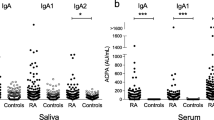Abstract.
Objectives:The limited number of studies addressing the presence of soluble human leukocyte antigen (HLA) in body fluids such as tears, urine, sweat, and saliva are restricted to healthy subjects. In this study, we applied solid-phase enzyme-linked immunoassay to quantify soluble HLA class I (sHLA-I) and class II (sHLA-II) molecules in saliva and in selected serum samples obtained from patients with systemic lupus erythematosus (SLE), rheumatoid arthritis (RA), and Sjögren's syndrome (SS). Results: While saliva from normal subjects (n=35) contained levels of sHLA-I that were undetectable (n=7) or ranged from 9 ng/ml to 70 ng/ml (30±3.7 ng/ml, n=28), sHLA-I among 38 patients with moderately active RA (n=24) or SLE (n=14) were significantly elevated (222±81.4 ng/ml and 120±27.3 ng/ml, respectively, P<0.0001). Intriguingly, sHLA-I levels were even higher in patients whose disease was regarded as active. Specifically, sHLA-I averaged 683±189 ng/ml in patients with active RA (n=13) and 230±24.5 ng/ml in patients with active SLE (n=7). This was significantly higher than in patients with milder forms of these diseases (P<0.0001). All five subjects with SS had severe disease with high levels of sHLA-I (mean 486±86 ng/ml). The concentrations of saliva sHLA-II in the disease groups studied were comparable with levels found in normal controls. The sHLA-I in severe and mild states was investigated in purified serum and saliva from a patient with SS. While 44-kDa fragments of serum HLA-I were detectable in severe SS, they were undetectable in saliva HLA at any time; 35–37-kDa fragments of serum or saliva HLA-I were detected during both mild and severe disease. Interestingly, the 39-kDa fragment was detected in both body fluids during severe but not mild forms of SS. Similarly, the isoforms with the molecular masses 39 kDa and 44 kDa were mainly identified in the purified material obtained from serum of SLE patients. Conclusions: Collectively, our data suggest that the measurement of soluble HLA in body fluids can be of both diagnostic and prognostic value in the assessment of patients with autoimmune rheumatic disorders. The mechanism by which sHLA enters saliva is unclear, but they probably are not acquired from serum.
Similar content being viewed by others
Author information
Authors and Affiliations
Additional information
Electronic Publication
Rights and permissions
About this article
Cite this article
Adamashvili, I., Pressly, T., Gebel, H. et al. Soluble HLA in saliva of patients with autoimmune rheumatic diseases. Rheumatol Int 22, 71–76 (2002). https://doi.org/10.1007/s00296-002-0173-3
Received:
Accepted:
Issue Date:
DOI: https://doi.org/10.1007/s00296-002-0173-3




